The Truck
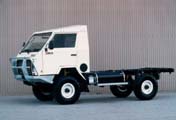
This is the previous model, the OKA LT.
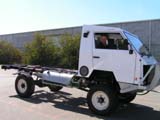
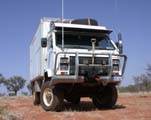
The left picture shows the new model, the OKA NT after
its "maiden" run, but still with a few parts missing.
The right picture shows the final result with the back-section
mounted.
The cabin is a welded steel frame covered by steel
plates and is roll over protected.
It still looks the same from the outside as the previous
model, but that's where most of the similarity ends.
The OKA NT is in many respects stronger and better
as its predecessor. Track width, wheelbase and overall
length are all slightly larger.
OKA uses a lot of "standard" automotive
components to build their trucks which should make
it (hopefully) relatively easy to get most of the spare-parts
in the future, including outside of Australia.
These trucks are mainly used for military and mining
purposes as well as by the Australian tour-operators
for their trips into the rough outback. This truck
is perfectly suited to be used as a camper due to its
size, payload and ruggedness.
Our OKA NT cab-chassis is driven by a Cummins 4-cylinder,
4-litre turbo charged and inter-cooled diesel engine.
It delivers 170 HP and has an enormous torque of 600
Nm. Highway-speed is up to 120 kmh.
Due to price reasons we chose the 5-speed, cable
shifted manual transmission gearbox.
4WD is engaged by a BAE / Vickers semi-permanent (also
cable shifted) transfer case.
The vehicle has cloth seat covers and tinted windows
and is registered to carry one driver and one passenger.
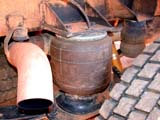
The trucks standard GVM is 6500 kg.
Additional air-springs are fitted by an aftermarket
company to increase the GVM to 7260 kg to comply
with legal requirements.
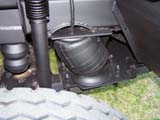
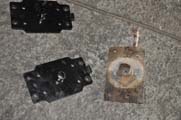
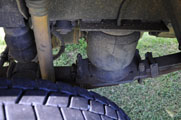
2010: The installed solution is technically flawed and mechanically of very bad quality. The whole airbag mounts have to be replaced.
2012: The whole suspension isn't sturdy enough for our wait and has too much play all over. We change the whole suspension with all its parts (spring package, shackles, shackle pins, bushes). All is done by the renowned Swiss company "Bieri Federn- u. Bremsservice AG" in Kriens, Luzern, Switzerland. The result is impressive. The OKA drives "like on rails". Below some details of the renovation.
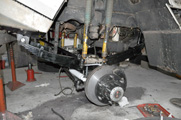 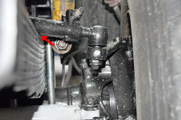 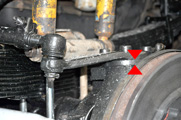 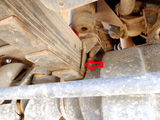
Front suspension: The new spring packages are thicker (all 10 mm leaves) and nicely staggered. To avoid the drag link contacting the spring package a spacer is required under the steering arm. On the right-hand side, a metal plate eliminates the notorious play.
 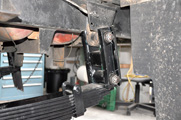 
Rear suspension: The new spring package and the new sturdy shackles. Front and rear are identical.
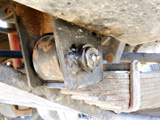 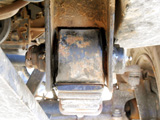 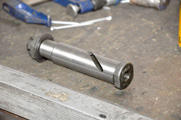
The new 24 mm Spring pins and the new mounting hardware on chassis and shackles. They are of German quality. No play anywhere.
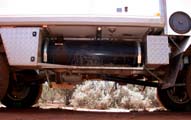
Fuel capacity is 115 litres in each of the 2 diesel
tanks.
The photo above shows the fuel tank on the right side.
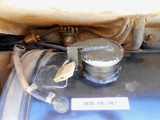
2012: The original, lockable fuel caps constantly brake. We replace them with new types. This is quite an ordeal. There are no unventilated, lockable fuel caps on the market and the non-lockable ones are also leaking. OKA needs sealed caps because its tanks have airing lines. If the cap is also ventilated the diesel leaks if the OKA is in a sloping position. After some trials and some Araldite, we are able to solve the issue. The tanks are now seriously locked - Fort Knox style.
Behind the fuel tank (left side of picture) a custom
built storage box was added.
In front of the tank the main battery is covered by
aluminium checker plate. OKA's main battery is normally
mounted on the opposite side and is not covered.
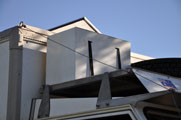
2010: The tank capacity is increased, mainly for South America. 4 jerry cans are stored in a box on the roof rack. They are normally empty.
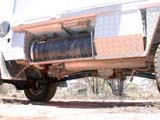
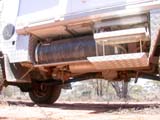
In front of the left fuel tank is the checker plate
covered floor heating compartment and at the back,
the standard OKA air step. The air step had to be relocated
because of the position of the door.
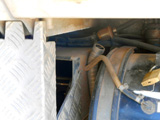 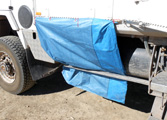
2013: In South-America some tracks climb to an altitude over 5000 m above sea level.
During the night temperatures can fall below -20°C.
This is a problem for the diesel fuel because it may gel even when using fuel additives.
If this happens the motor cannot be started since the diesel clogs the fuel filter.
Also, the Diesel heater will probably get in trouble under such conditions.
To overcome that problem as good as possible we cut a hole into the heater cover and moved the exhaust of the heating above the diesel tank.
With a blanket we conserve the heat of the heating and warm the diesel in the tank.
Under such conditions the motor will be heated anyway at night.
The black round cover at the front (left side of picture)
hides the various air valves for the diff-locks, air
steps etc.
Below the tank is the red PTO (Power Take Off), the
blue hydraulic motor and the 30-litre hydraulic oil
tank.
All of it is used for the hydraulic winch.

Each fuel tank has its own sediment bowl and filter
to trap water and dirt.
Above the diesel filter on the right side is the easy
accessible air filter.
Dust from the
air filter exits just below the filter due to the overpressure
within the filter case.
Also due to the overpressure and the shape of the nozzle,
no water enters the filter even if submerged.
There
is a snorkel built into the cab bodywork.
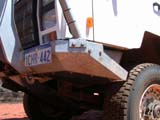
The new optional bull bar is bolt-on and therefore
easy to repair. The bull bar is delivered with two
antenna attach points.
Bull bar and bumper are both
hot dip galvanised.
Two strong recovery hooks at front are standard and
are built into the chassis.
The main lights are covered by strong stainless-steel
mesh for stone protection.

We added cables between the bull-bar and the back-section
to protect the cab from branches while driving through
bushland and forests.
Branches up to 5 cm simply bend
away or break.
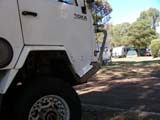
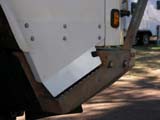
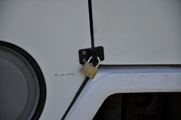
2010: For improved security reasons on our world tour
the standard entry steps on the bull bar are now covered
to prevent somebody from climbing on the rolling truck.
This happened to Ruedi in his VW-camper in Italy in
1973.
Padlocks have been added to further secure the doors and the side windows are now laminated and shatter proof.
2013: In Tacna (Peru) the door on the driver side was forcefully opened.
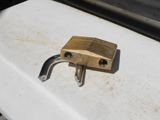
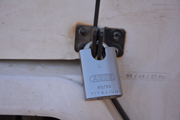
The "locking bow" of the padlock (grade 4) was ripped off in no time with some sort of a crowbar.
We now use stronger padlocks (grade 8) from Abus (90/50 Titalium).
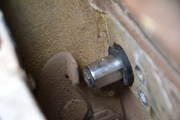
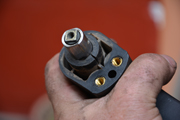
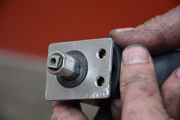
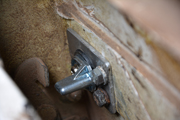
The standard door lock was forcibly turned open using a screwdriver.
This is easy because the door handles are made from plastic and offer no resistance.
The new door locks are reinforced with an aluminium plate to add more security.
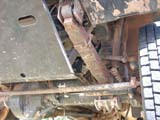
The leaf springs have four layers under the eyelet
making them much less likely to break.
There are 4 double acting, gas charged shock absorbers
installed on the front axle (2 are optional).
Clearly visible is the new 8 t axle with the optional
air locked differential.
Many of the vulnerable parts are protected by bash
plates.
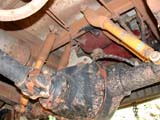
The back axle also has 4 shockies (2 optional) and
has an optional air operated diff lock installed.
Front and rear axles have no stabilisers (anti sway
bars) installed. The axles have an incredible articulation
of 14 inches.
2011: After the many problems we had mainly with the diffs (2 axles and 8 diffs replaced on warranty) we decided to remove the diff-locks for good.
Diff-Locks put a lot of strain on the drive train and our axles are of the worst possible quality.
These two parameters simply don't match. In addition, our vehicle is very heavy and this adds even more strain to the whole system.
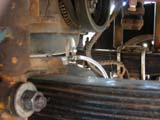
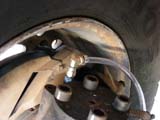
2010: The hubs are prepared for "Central Tyre
Inflation" and have also connection for hub-breathers.
Since there is a seal between hub (greased) and differential
(oiled) the hubs should have breathers installed to
avoid water from entering the hubs while wading through
cold water. This has now been done.
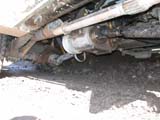
Visible in the middle of the picture is the cable
shifted 2 stage transfer case and the flange bolted
drive shafts.
Huge ventilated disc brakes are used on both axles.
They are power boosted by air over hydraulics.
Right behind the transfer case (visible as a round
thick disc) is the air actuated park break.
Since it
is connected to the transfer case it works on all 4
wheels if in 4WD.
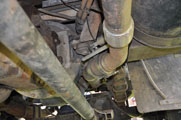
2010: Due to our weight the brake power of the motor is insufficient. We decide to be the first clients to install an exhaust brake, a "PacBrake".
The result is fantastic. The exhaust brake is controlled by the electronic motor management system (ECM).
Never the less it can be manually switched on or off at any time using the brake pedal or accelerator.
At the same time, we exchanged the exhaust system with a stainless-steel version.
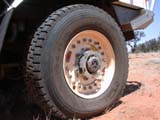
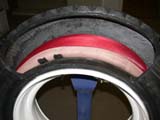
The 305/70 R 19.5 Michelin XDE 2+ tubeless tyres are
mounted on "Titan"
19.5" x 8 1/4" bolt-together rims.
"Second-Air"
bead-locks are fitted to the wheels to prevent the
tyres from sliding off the rim when driven with very
low pressure (mainly on sand).
2009: The bead-locks have been removed.
They constantly
destroyed themselves when the tyre slightly slipped on
the rim when breaking hard.
(Apparently the newest version of the bead-locks has been improved
to hopefully avoid this problem.)
The front wheels are equipped with AVM free-wheeling
hubs to reduce fuel consumption while driving in 2WD.
The free-wheeling hubs are protected by hub steps.
To help in difficult terrain the truck is equipped
with optional air-operated diff locks front and rear.
All the above (except the tyres) are options supplied
by OKA.
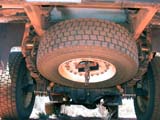
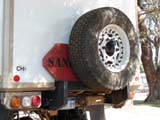
Normally the spare wheel is installed at the rear
end of the truck, adversely affecting the departure
angle.
2009: We build a new and lighter spare wheel carrier
which also carried the 6 fibre glass sand boards.
The
second spare tyre is still on the roof rack.
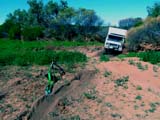
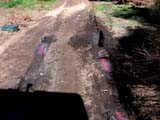
The hydraulic winch (OKA optionally supplies the Warn
M15000 electrical winch) is mounted to the chassis
behind the first cross member.
The synthetic rope runs through a standard fairlead
which is also fixed to the chassis and not to the bumper.
The winch runs on a hydraulic motor driven by the power
take off on the main gearbox.
The winch is operated
from inside the cab. It has its own 30-litre oil tank
and can be run constantly but only as long as the motor
runs.
This is not a major concern as an electrical
winch of that size with such a heavy load would also
not work for long if the motor stalls or not at all
if in salt water.
The chance that the motor fails at the same time as
the truck is bogged is very unlikely except if caught
in very deep water.
The only real disadvantage of a
hydraulic winch is that actively driving and winching
is not possible at the same time. But this is not recommended
anyway.
For places where there are no trees available we carry
a ground anchor. As recovery sessions in soft sand
have shown the truck simply pulls the ground anchor
underground through the sand making recovery even more
challenging.
2010: In many recovery situations the ground anchor has never worked as expected. It has been removed.
In the future we will use our spare wheel instead, as many others also do.
We also carry glass-matt type sand-ladders which have
already proven to be very rugged and reliable even
for this heavy weight truck.
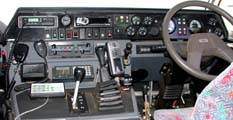
OKA's standard dashboard takes up 2/3 of the cabin's
width. It contains all the standard instruments and
switches and has additional pre-defined slots for a
UHF CB-radio, some more instruments and switches.
The added UHF CB radio (not supplied by OKA) is at
the upper left corner to be operated by the co-driver.
The radio/CD/MP3 player (OKA supplies a different type)
has an attached interface to be able to use an iPod
as music source when no radio stations are available
in the outback.
The 2 red switches below the radio operate the PTO
used for the hydraulic winch and the free spooling
of the winch.
The middle console holds (from left to right):
- UHF radio microphone
- HF radio speaker (2010: removed)
- HF radio microphone (2010: removed)
- HF radio remote console (2010: removed)
- Hot-standby GPS (mainly used for biking and hiking)
- Compass (2010: removed)
- Lever for the air-operated handbrake.
The handle at the bottom of the picture right of the
console operates the hydraulic winch.
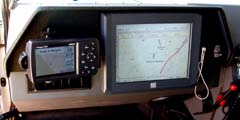
The console at the left side of the truck has been
custom-built for navigation and holds the main GPS,
the on-board PC's touch screen monitor and the switch
to start the PC.
Both screens are readable in full sunlight.
The HF transceiver and the iPod holder are installed
alongside the co-driver's right leg.
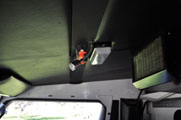
2010: The co-pilot gets its own spotlight. The HF-transceiver has been sold. It had never been used and without a special permit it would be illegal to use it internationally.
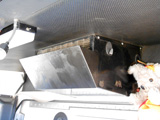
2012: One known annoyance of the OKA's rear cab air-condition is that it every so often splashes water into the driver cab.
This is due to the fact that the condenser unit is mounted exactly level.
The condensing water collects at the condenser unit until the driver stops sharply.
Then the accumulated cold-water splashes onto the driver and passenger without any warning.
The unwelcome bath can be avoided by adding a splash-wall in front of the condenser unit which defers the water back into the air-condition housing and down the drain tubes.
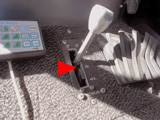
2012: The motor bay has been insulated using a heavy carpet. This drastically reduces the mid- and hi-frequency noise in the cab (seen in Oz in Dave Hallendal's OKA).
2013: Since South-Africa we had problems using the 4WL or 4WH.
Either of the two did not engage correctly and/or fell out of gear.
If both were correctly setup the Neutral or/and the 2WH where failing.
There are 3 possible reasons for this to happen:
1. Too much play in the lever in the dash
2. Wrong adjustment at the transfer case and
3. The matrix for the lever is produced out of tolerance. On our OKA point 2 and 3 where the case.
The play was fixed in Germany but it didn't fix the problem.
We now rebuilt the matrix to the correct measurements and now it works fine (just cut the metal plate apart, turn the right side and drill/grind/file your new matrix).
Neutral and 2WD were out of tolerance by some millimetres.
Also, the angles of the "teeth" should be in line with the different lever position and not 90° to the matrix. This eliminates wear.

Behind the co-driver's seat a small shelf has been
fitted.
On top are 2 red boxes containing survival and medical
supplies.
Should the truck catch fire they can be removed
very quickly.
Above the red boxes, two breathing masks are mounted
against the back wall.
They will prevent smoke intoxication
for up to 10 minutes as long as there is enough oxygen
available.
This should (hopefully) be enough time to escape if
caught in burning forests, heavy bush fires or in tunnel
accidents.
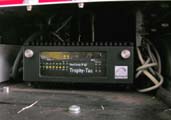
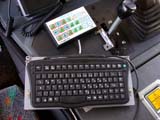
A PC is installed under the shelf. It is a Swiss
made military grade product.
It is fully shock, dust,
and water resistant and can be used even on heavy corrugated
roads.
The PC is operated by a dust and water resistant standard
keyboard as well as a special keyboard designed for
the navigation software.
The PC is used for navigation, up and downloading
maps, tracks, routes and waypoints to and from both
GPSs.
All data is administrated in the navigation software.
In addition, email can be sent and received via the
sat-phone using special software.
This can be done even while driving on the road at
any time and in about any place in the world.
Internet access is possible using the USB modem. It
works with reasonable speed also in most of the smaller
villages.
The generated data is regularly saved on a network
disk on the (wireless) LAN hub installed in the back-section.
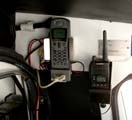
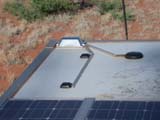
The sat-phone is located above the co-driver's seat
and the battery is constantly being charged.
A headset also allows phone calls while on the move.
The antennas for the sat-phone and for both GPSs are
located on the roof of the back-section to guarantee
optimal reception.
An additional handheld UHF CB-transceiver is located
beside the sat-phone. Its battery is also constantly
being charged.
The transceiver can be removed and used to keep contact
between the co-driver and the driver while the co-driver
is outside the vehicle or is examining the track ahead.
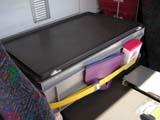
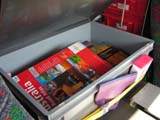
Between the 2 seats a Swiss made Rako-Box contains
all the maps, travel-guides and other items permanently
used.

A 6 kg foam-type fire extinguisher, an electronic
rust protection unit, the dual battery charger as well
as other often used tools are all located behind the
driver's seat. |

![]() Created by Level X Webdesign
Created by Level X Webdesign